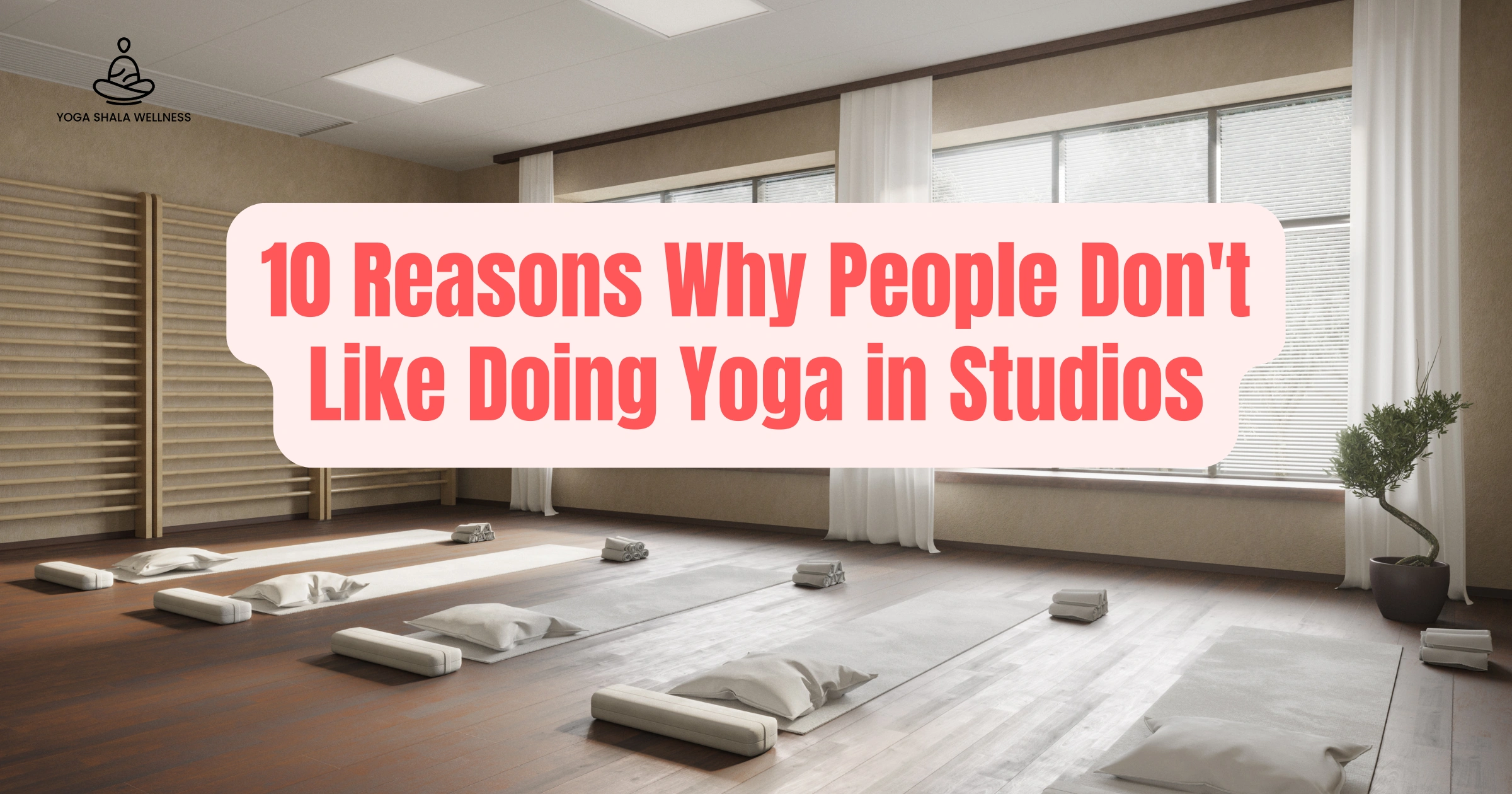Yoga has been a tradition for thousands of years as a means for strengthening the body, soothing the mind, and cultivating the spirit. For some, the yoga studio is a sanctum—a haven where they can breathe deeply, move with awareness, and be around a community of like-minded individuals. Yet, not everyone has such feelings.
In reality, there is an increasing number of individuals who would rather unroll their mat in the comfort of their homes, stream a class from the internet, or even just practice alone. They don’t object to yoga itself (indeed, many of them are avid practitioners themselves); they just don’t appreciate the studio scene.
So why do some individuals not enjoy practicing yoga in studios? Let’s explore the reasons further.
1. The Cost Factor
One of the most common reasons people avoid yoga studios is the price tag. Monthly memberships can range anywhere from $100 to $250 depending on the city, with some boutique studios charging even more. For a person with time for just one or two classes a week, that math does not necessarily compute. Throw on expenses for mats, props, or specialty workshops, and all of a sudden yoga becomes a luxury item rather than a practice in health available to all.
Practicing at home, on the other hand, is simply a matter of having an internet connection and a mat. Free YouTube classes, low-cost apps, and online memberships enable individuals to practice for a fraction of the price without worrying about whether they’re “getting their money’s worth” out of studio memberships.
2. The Comparison Trap
Yoga is often described as a personal, non-competitive practice. But place someone in a room with 20 or 30 others, some effortlessly holding advanced poses or balancing in headstands, and it’s hard not to compare.
For beginners especially, the studio environment can spark feelings of insecurity. Instead of focusing inward, they start wondering:
- “Why can’t I touch my toes like her?”
- “Am I doing this pose wrong?”
- “Do I look out of place here?”
These distractions erode yoga’s meditative essence. At home, no one compares to just you, and one can do yoga peacefully.
Also read: Yoga Pants or Leggings: What’s the Difference and What Do You Wear?
3. Instructor Compatibility
Yoga teachers are instrumental in establishing the mood and efficacy of the studio. An outstanding educator can develop an environment that encourages development, creates a network of students who support each other, and focuses on student safety and personal advancement. On the other hand, an unsuitable instructor can disempower these constructive factors, resulting in disappointment and an inferior learning experience for students.
Students commonly complain about several kinds of teaching deficiencies. These are instructors who:
- Use overly complicated or Sanskrit-rich prompts: Although Sanskrit finds its place within conventional yoga, too much of it or without explanation can leave newbies or those who are not familiar with the language confused, impeding comprehension and continuity. Easy, direct, and understandable instruction takes priority for good learning.
- Rush through sequences without sufficient explanation: Rushing through sequences of postures without a full explanation of alignment, modifications, or the reason behind each pose can be daunting and even risky. Students must have the space to take in instructions and perform movements safely and consciously.
- Overemphasize physical movement over mindfulness: Yoga is not only physical postures; it’s a comprehensive practice that involves breathwork, meditation, and an increased awareness of self. Instructors who only emphasize the physical will overlook the deeper and more life-changing aspects of yoga and leave students unsatisfied or disconnected from the practice’s reality.
Historically, searching for a yoga teacher who really understands an individual’s needs and tastes has been a case of trial and error. This can be a time-consuming and sometimes costly process, requiring the taking of many classes at varying studios. The introduction of online yoga websites has, however, dramatically changed this process. These online resources provide a previously unmatched benefit, enabling practitioners to browse an immense range of teachers from all over the world with great ease. With a few clicks on the mouse, students can try out thousands of various teaching styles, modalities, and personalities, greatly enhancing their opportunities to find the perfect teacher who will match their personal path and aims to a “T.” This availability has democratized the search for a compatible teacher, becoming less taxing and more effective for committed practitioners.
Also read: What is Discipline in Yoga | Sanskrit Wisdom, Paths, and Daily Practice
4. Fear of Judgment
Although yoga philosophy encourages non-judgment, the truth is that walking into a studio can be intimidating. Individuals fear being judged on:
- Not wearing the “right” yoga attire or mat.
- Struggling with particular poses.
- Not being flexible, strong, or “zen” enough.
This fear keeps others away from studios completely. Working from home eliminates the social pressure. A shaky crow pose or an unbalanced warrior II is irrelevant if one is not being judged.
To many, that anonymity facilitates their ability to accept vulnerability and move forward at their own pace, free from the burden of other people’s opinions.
5. Time and Convenience
In our busy world today, finding time to drive to a yoga studio just isn’t practical. Picture fighting rush-hour traffic for 45 minutes to go to a 60-minute class and then again driving home for 45 minutes. The anxiety of making it there may negate the relaxation that yoga is supposed to bring.
Home-based yoga, however, blends in with the rhythm of daily life. You can get on your mat early in the morning, fit in a 20-minute flow at lunchtime, or wind down with restorative stretches late at night. Convenience and flexibility make it much easier to be consistent.
6. Variety of Learning Styles
Everyone learns in their own way. Some love in-person learning with the option to ask questions face-to-face and get hands-on adjustments. Others like the independence of self-directed instruction.
Yoga studios tend to have a pre-established sequence and tempo that doesn’t take into consideration personal requirements. To illustrate, a beginner student could get lost in a rapid vinyasa class, while an experienced yogi could find a slow flow boring.
Online yoga resources, on the other hand, have something to suit every level, interest, and time commitment. Need a 10-minute morning stretch? An hour’s power yoga flow? Or a relaxing meditation with breathing exercises? The web offers unlimited choices for personal taste.
7. Studio Culture and Environment
The studio setup itself may also be a deterrent: cramped rooms, restricted mat area, uneven temperature control, or even blasting playlists that have nothing to do with mood. When practicing at home, people have complete control over their setting—lighting, music, temperature, and vibes. Yoga studios offer diverse environments, and their suitability often depends on individual preferences. Some studios cultivate a warm, inclusive, and community-driven atmosphere, fostering connections among practitioners. In contrast, others might exhibit a more exclusive or even competitive dynamic, which can be less appealing to those seeking a different experience.
For many, particularly introverted individuals or those who simply prefer solitude, the inherently communal aspect of yoga studios can be a deterrent. These practitioners may not desire pre-class discussions, post-class socializing, or active participation in a community. Their primary goal is simply to engage in their practice without additional social obligations.
Beyond the social dynamics, the physical setup of a studio can also significantly impact a practitioner’s experience. Common deterrents include cramped practice spaces, insufficient mat area, inconsistent temperature regulation, or even jarring, inappropriately loud music that disrupts a meditative mood. In stark contrast, practicing yoga at home provides complete autonomy over one’s environment, allowing for personalized control over lighting, ambient sound, temperature, and overall atmosphere, ensuring a truly tailored and comfortable experience.
8. Negative Past Experience
For others, it’s a matter of personal experience. Perhaps they had an instructor in the past who made them feel inferior. Perhaps they were in a class where they felt overlooked, invisible, or even belittled. Bad first impressions last. And for someone who already feels nervous to get onto the mat, one disappointing experience is enough to keep them from studios forever.
At home, the possibility of embarrassment or discomfort is low. Progress can be made slowly, without outside pressures. When encouraging individuals to engage in physical activity, especially those hesitant about public settings, consider the following:
- Emphasize a supportive and non-judgmental environment: Highlight features like personalized attention, instructors focused on encouragement over criticism, and a community that values individual progress rather than competition.
- Offer private or semi-private options: For those with deep-seated anxieties, one-on-one sessions or small group classes can be less intimidating than large, open studios.
- Promote at-home fitness solutions:Acknowledge the comfort and safety of home workouts. Provide resources, guidance, and programs tailored for home use, emphasizing freedom from external scrutiny.
- Focus on individual journeys and progress: Shift the narrative from “perfect performance” to gradual improvement and personal milestones. Celebrate small victories to build confidence.
- Address past negative experiences directly (with sensitivity): While not probing, create an open dialogue where individuals feel comfortable sharing their hesitations, allowing you to offer specific reassurance or alternative solutions.
- Highlight the mental and emotional benefits: Beyond physical health, emphasize stress reduction, improved mood, and increased self-esteem as key outcomes, which can be particularly appealing to those with past psychological barriers.
- Provide trial periods or introductory offers: A low-commitment entry point can reduce the perceived risk of a “bad first impression” and allow individuals to experience a positive environment without pressure.
9. The Power of the Internet
One of the largest factors drawing individuals away from studios is the overwhelming availability of high-quality yoga on the internet. Sites such as YouTube, Instagram, and niche applications provide access to top-of-the-line instructors, varied class styles, and structured programs.
Unlike studios, the internet provides:
- Replay and repeat of classes.
- Halting to disassemble challenging postures.
- Trying various styles (yin, ashtanga, kundalini, restorative, etc.).
- Practicing wherever—at home, in the park, or even on the road.
Such ease democratizes yoga so that it becomes accessible to everyone, anywhere, at any time.
10. Yoga as a Personal Journey
Essentially, yoga is a very personal practice. Some individuals excel in a group setting, while others prefer to be alone. Neither is superior to the other—it merely depends on personal preference.
For those who do not opt to practice at studios, it doesn’t necessarily mean that they adore yoga any less. In truth, their insistence on practicing at home, sometimes with no outside encouragement or praise, says a lot about their commitment.
Conclusion
Studios can be great places for learning, connection, and expansion. But they’re not for everyone, and that’s alright. Whether practiced in a peaceful studio filled with candlelight and soft music or in the far corner of a bedroom with a computer streaming YouTube, yoga is the same: to find balance in the body, mind, and spirit.
What matters is not where you practice, but that you do.
So, do you prefer the community and energy of a yoga studio or the privacy and flexibility of at-home yoga? Either way, the beauty of yoga is that it meets you exactly where you are.
If you’re looking for a welcoming space to deepen your practice with guidance and care, we invite you to visit Yoga Shala Wellness.

